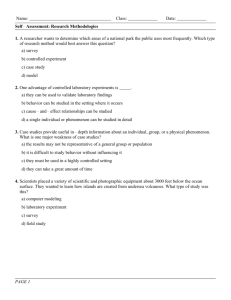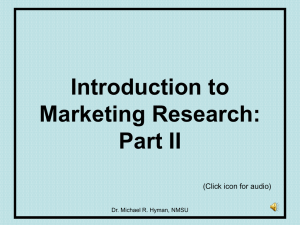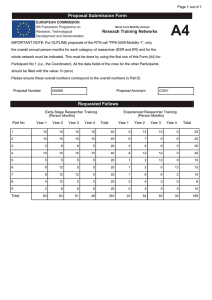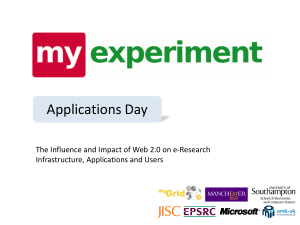Can open science be a shared space for members of... together?
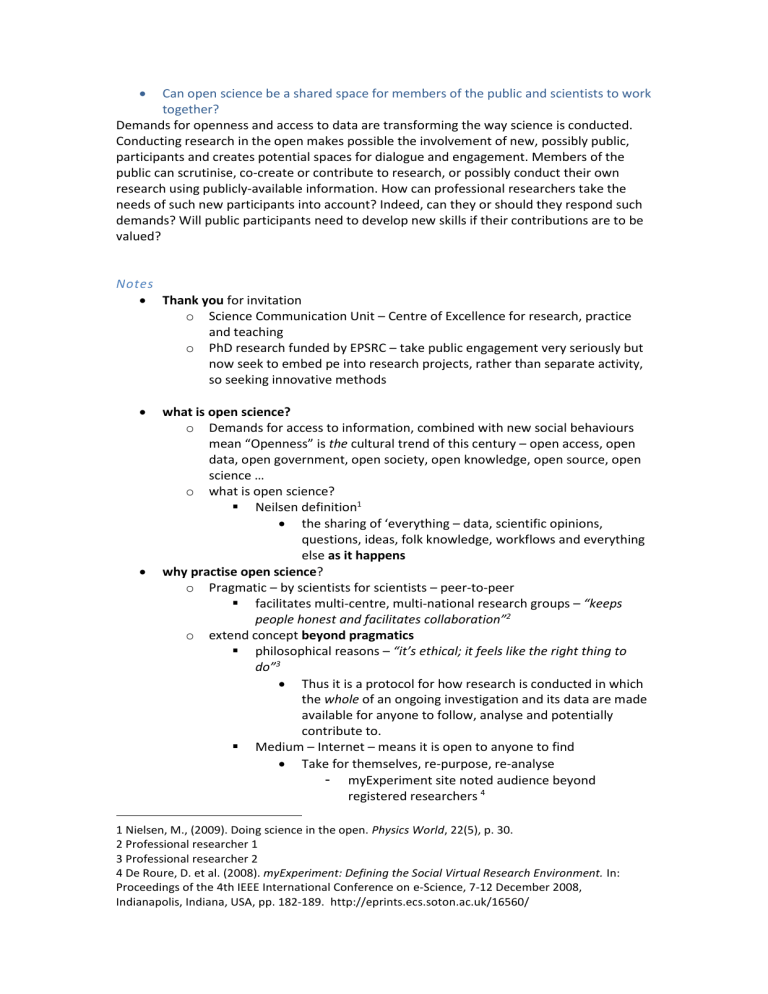
Can open science be a shared space for members of the public and scientists to work together?
Demands for openness and access to data are transforming the way science is conducted.
Conducting research in the open makes possible the involvement of new, possibly public, participants and creates potential spaces for dialogue and engagement. Members of the public can scrutinise, co-create or contribute to research, or possibly conduct their own research using publicly-available information. How can professional researchers take the needs of such new participants into account? Indeed, can they or should they respond such demands? Will public participants need to develop new skills if their contributions are to be valued?
Notes
Thank you for invitation o Science Communication Unit – Centre of Excellence for research, practice and teaching o PhD research funded by EPSRC – take public engagement very seriously but now seek to embed pe into research projects, rather than separate activity, so seeking innovative methods
what is open science? o Demands for access to information, combined with new social behaviours mean “Openness” is the cultural trend of this century – open access, open data, open government, open society, open knowledge, open source, open science … o what is open science?
Neilsen definition 1
the sharing of ‘everything – data, scientific opinions, questions, ideas, folk knowledge, workflows and everything else as it happens
why practise open science? o Pragmatic – by scientists for scientists – peer-to-peer
facilitates multi-centre, multi-national research groups – “keeps people honest and facilitates collaboration” 2 o extend concept beyond pragmatics
philosophical reasons – “it’s ethical; it feels like the right thing to do” 3
Thus it is a protocol for how research is conducted in which the whole of an ongoing investigation and its data are made available for anyone to follow, analyse and potentially contribute to.
Medium – Internet – means it is open to anyone to find
Take for themselves, re-purpose, re-analyse
myExperiment site noted audience beyond registered researchers 4
1 Nielsen, M., (2009). Doing science in the open. Physics World, 22(5), p. 30.
2 Professional researcher 1
3 Professional researcher 2
4 De Roure, D. et al. (2008). myExperiment: Defining the Social Virtual Research Environment. In:
Proceedings of the 4th IEEE International Conference on e-Science, 7-12 December 2008,
Indianapolis, Indiana, USA, pp. 182-189. http://eprints.ecs.soton.ac.uk/16560/
This is where the potential spaces for dialogue and engagement are created
Allows whole process of science to be open to anyone
Not just polished results or data but messy, uncertain, tentative, dynamic process
Members of the public can scrutinise, co-create or contribute to research, or possibly conduct their own research using publicly-available information. o Offers space for understanding of the nature of the scientific process o OPERA experiment controversy showed how science worked through discussion and resolution 5 o Public could get hold of data if they wanted to 6
What does it mean in practice? o continuum of openness
very little research totally closed - far end - open notebook – 5%
(RIN) 7
open notebook “the practice of making the entirety of one’s laboratory notebook and all associated raw data public as soon as possible” 8
most people sit somewhere along the line – blog, website, wiki, repository
Tools o web 2.0 & social media
13%; no particular age/job slant; some ‘official’ sn; also semiprivate. (RIN)
Through tools and philosophy o Tools are predicated on notion of online communities o Render boundaries between communities fluid –
platforms for real-time, person-to-person communication
means two-way – and possibly symmetrical – communication, writer/organisation can hear and respond o potential to support contribution from wider audience
science extends to audiences beyond peers and superiors opens up audiences e.g. co-workers, other scientists, different public communities of all kinds
audiences o Flow of information can be one-way o But also crossover - public audience acknowledged – blogs, updates, data o using audience and generating dialogue
scrutiny through the project (and collaboration) – Polymath Project
(Gowers) collaborative proof of Hales-Jewett theorem 9
5
6 OPERA Collaboration, (2011). Measurement of the neutrino velocity with the OPERA detector in the
CNGS beam. http://arxiv.org/abs/1109.4897v1
7 Research Information Network, (2010). If you build it, will they come? How researchers perceive and
use Web 2.0. www.rin.ac.uk/web-20-researchers
8 Professional researcher 3
9 Cranshaw, J. and Kittur, A. (2011). The Polymath Project: lessons from a successful online
collaboration in mathematics. CHI 2011, May 7–12, 2011, Vancouver, BC, Canada.
much of the audience were specialists but some very significant comments came from those who scored low on seniority / amateur collaborators 10
public participation o Increasing numbers of “digital residents” – people who see the Web as a place to express opinions, form relationships, develop an identity and belong to a community
expectation that the Web is the place where information is created as well as communicated o open science offers direct, unmediated engagement with process
activities can be integral with everyday work and information flows directly from the researchers o Participants come from a range of communities
range of expertise & skills
willingness
Citizen science projects show public willingness to become involved, e.g. Galaxy Zoo 11
but mostly use public as resource for data organising – essentially passive, limited, not analytical 12
DART open archaeology welcome participation of skilled / resourceful amateurs 13
Evolution Megalab – published methods for data collection/recording 14
Muki Hacklay – Excites – developing structures that “allow any
community to start a Citizen Science project that will deal with the issues that concern them”
context o os allows participants to be more than data organisers – to analyse, synthesise and contribute thought o But information needs to be more than accessible
It’s only ‘available’ if it means something; it’s not ‘available’ if it’s just there but means nothing or there’s no map to navigate through
it in some way or no support to find your way through 15
“narrative is utterly utterly essential” 16 o professionals
can / should / how projects take public needs into account? o what kinds of material can/are made open?
could just throw out raw data – no context – no feedback;
Nature article – data must be meaningful and user- friendly 17
10 New Scientist. (2011). How to build the global mathematics brain 7th May 2011, vol. 2811 pp 10-1
11 Galaxy Zoo, (2010). Home. http://www.galaxyzoo.org/
12 Haklay, M., (2011). Extreme Citizen Science – ExCiteS [blog]. http://povesham.wordpress.com/2011/03/07/extreme-citizen-science-excites/
13 DART, (2010). The DART project. http://dartproject.info/WPBlog/
14 Worthington, J., et al. (2011). Evolution MegaLab: a case study in citizen science methods. Methods
in Ecology and Evolution, 3 November.
15 Professional researcher 4
16 Professional public engagement practitioner 1
17 Nature. (2011). A little knowledge (editorial) Nature 472 p. 135
how useable is raw data? what uses might it be put to? do users have to be ‘educated’ to set data in context? o need for good communication and connexions
layers in the record to allow people to access at different stages but flow up or down to different layers, depending on need/skills
“Maybe you need several layers of reporting, of analysis.” 18
What new skills will public engagement through open science need? o researchers
new tools need new skills (possibly) – but may be re-purposed old tools
implications for day to day work – is it taking time away from the ‘real’ work? o Engagement through OS analogous with early days of PEST – offline, under the radar, voluntary
Differences in disciplinary ethos may cause strains in multi/trans/inter-disciplinary projects – different norms regarding personal information o But new social mores may overtake standing research practice, e.g. sharing websites such as
PatientsLikeMe 19
dedicated time
to provide contextual information, narrative, resources, respond to input
Real work involves reflection, analysis, thinking o public
gaining access, interpreting information, understanding scientific structures, trust
reputation judgements – e.g. MathOverflow, 20 i-Spot 21 o analogue of real-world judgements – mix of ‘friend of a friend’ and external validation
Can open science be a shared space for members of the public and scientists to work together?
Aspiration, opportunity & method
aspiration – desire to be open / desire to engage with science / to engage others
opportunity – emerging norms
method – new tools and practices
18 Professional researcher 2
19 http://www.patientslikeme.com/
20 MathOverflow, (n.d.). What is reputation?. http://mathoverflow.net/faq#reputation
21 Clow, D., and Makriyannis, E. (2011). iSpot Analysed: Participatory Learning and Reputation. In:
Proceedings of the 1st International Conference on Learning Analytics and Knowledge, 28 February-01
March 2011, Banff, Alberta, Canada.
